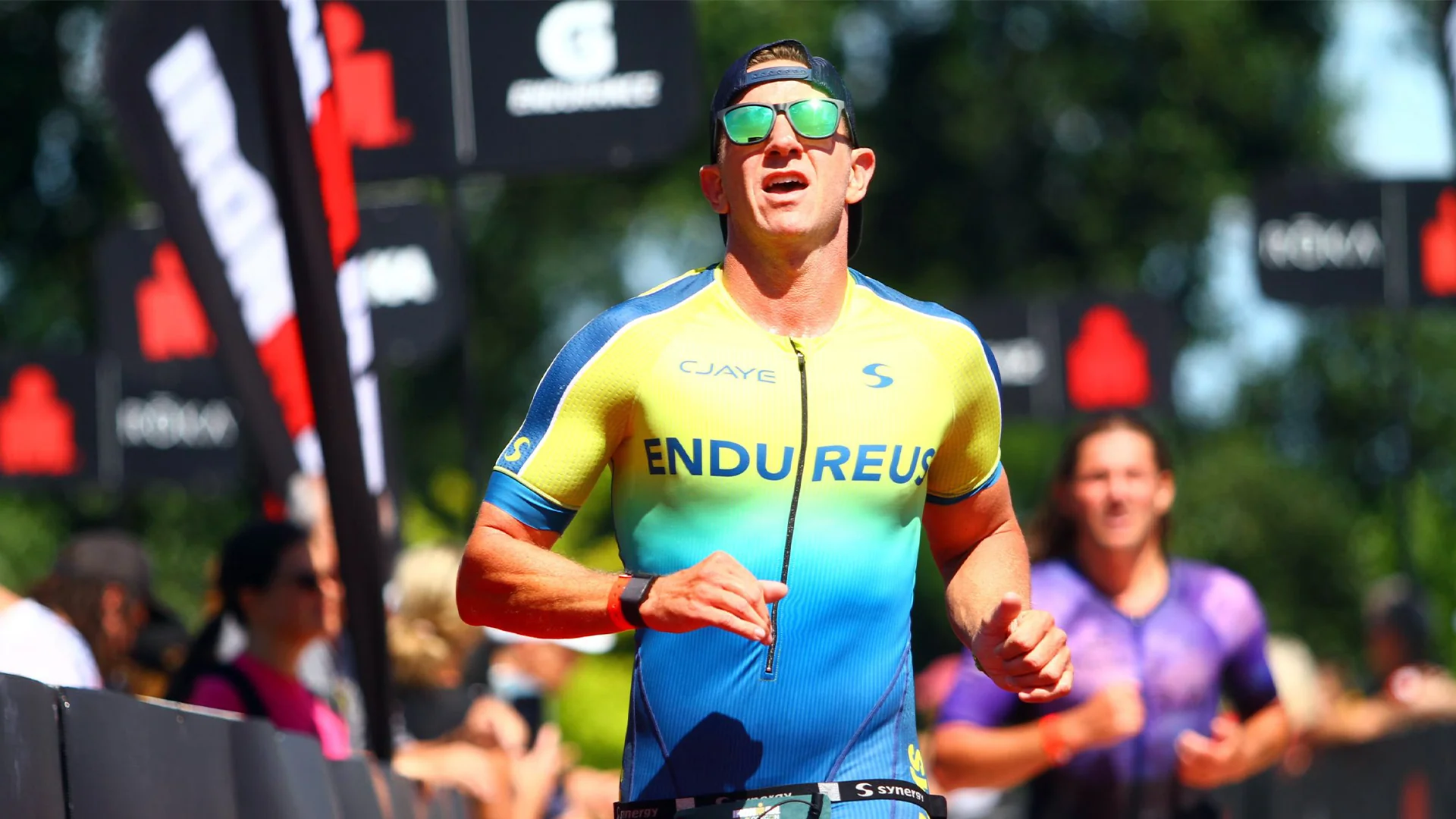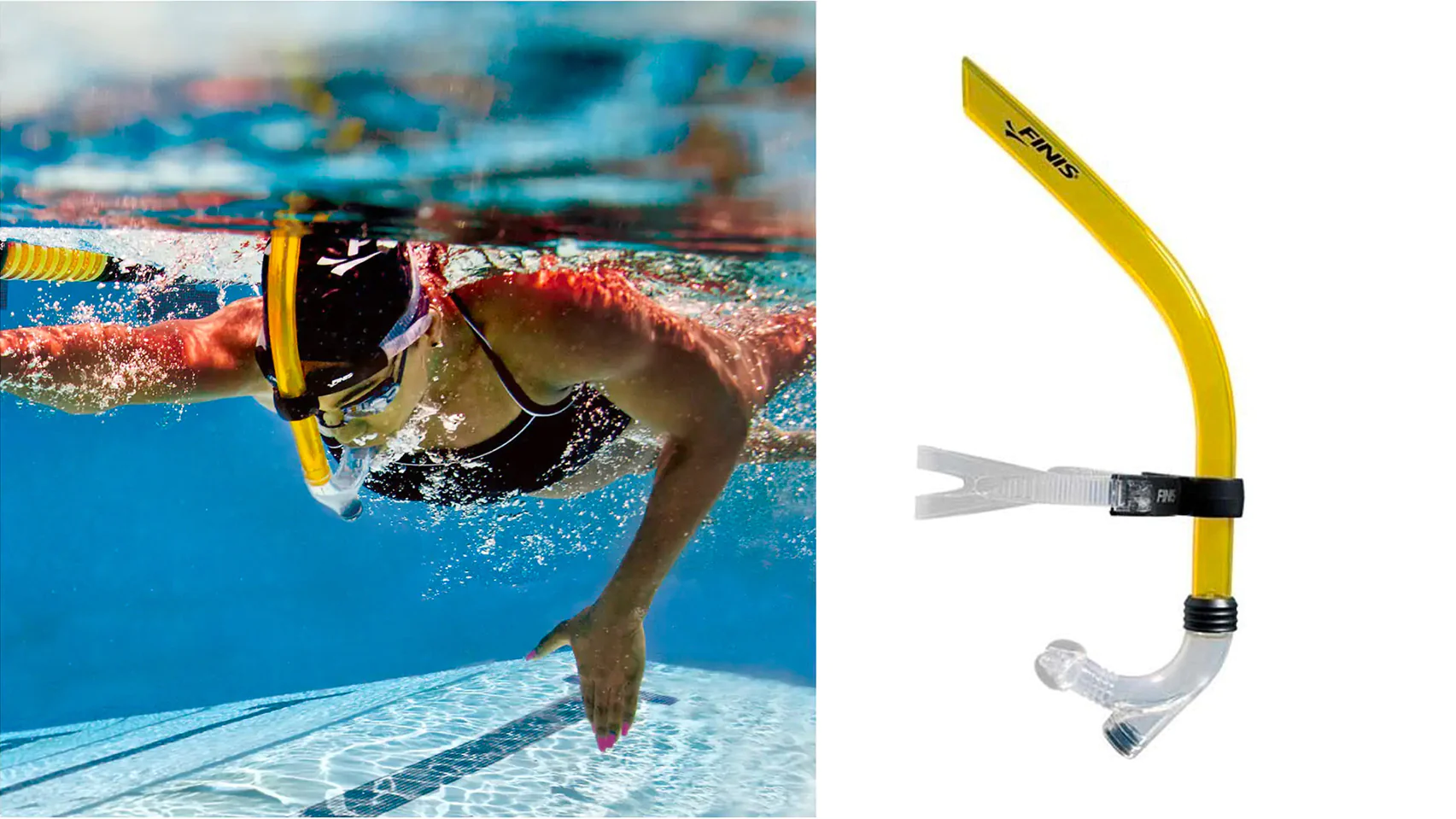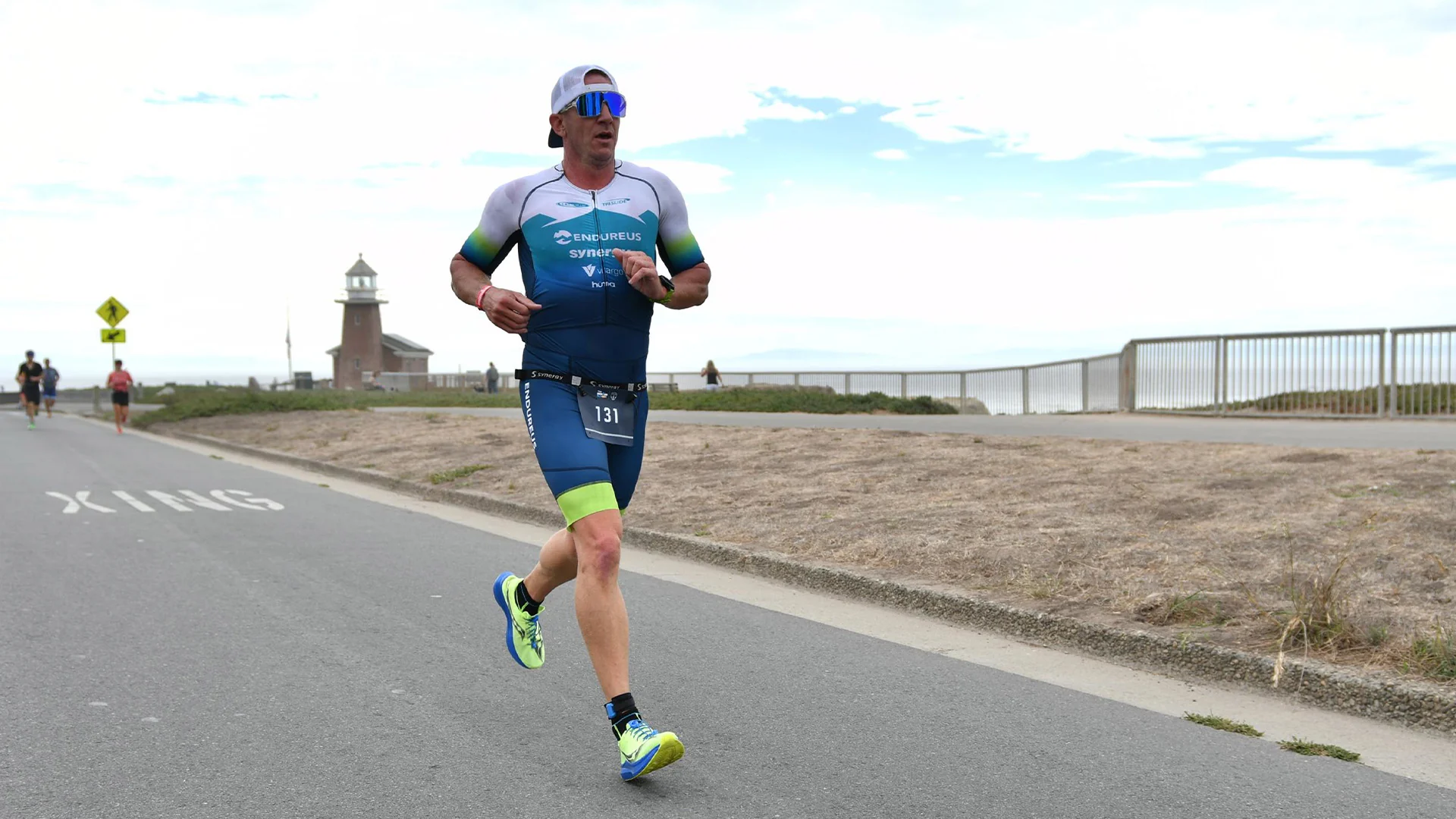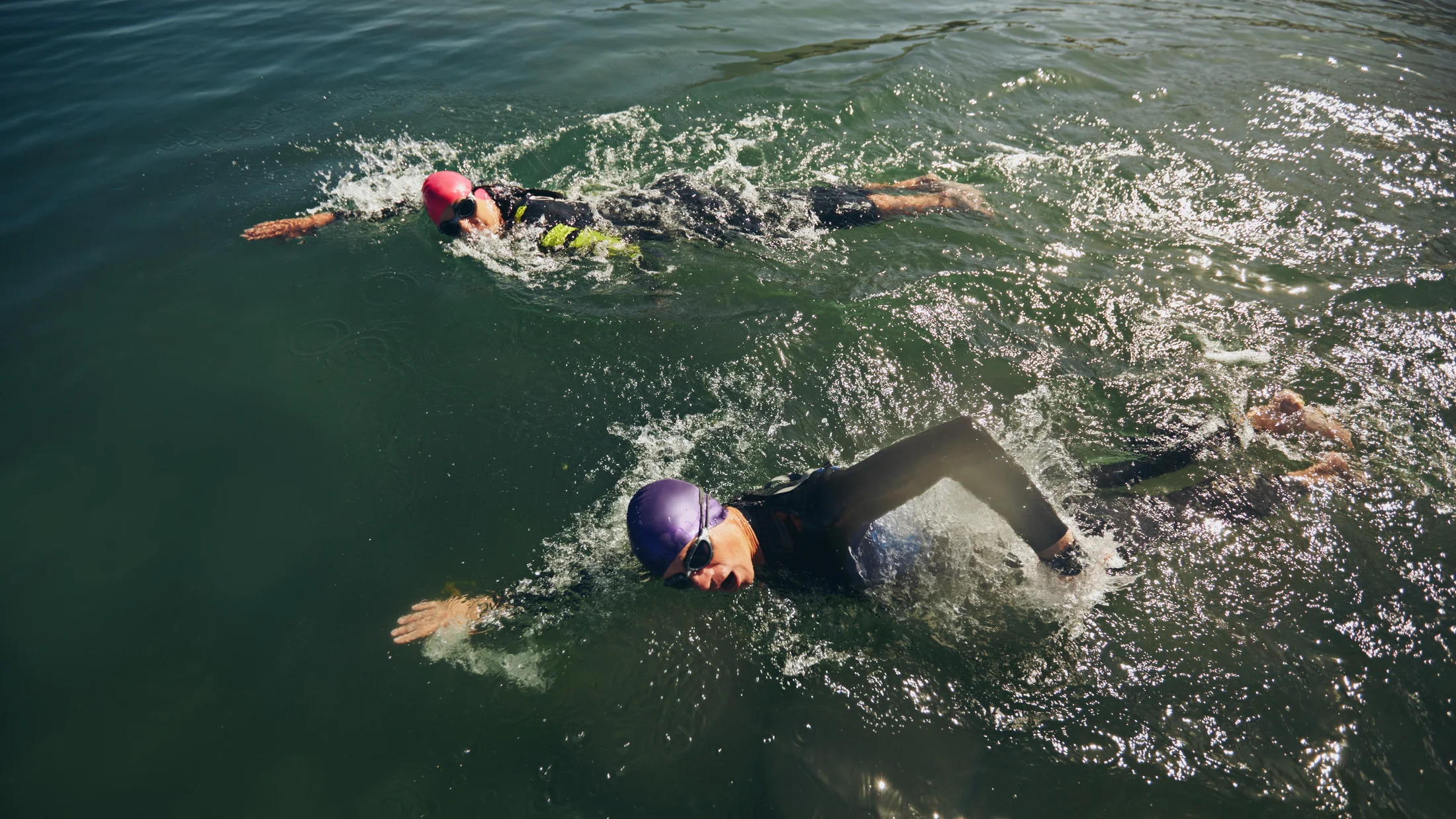With its combination of swim-bike-run disciplines, triathlon can be a complex and challenging event. It may feel like navigating a minefield with potential pitfalls at every turn for first-time triathletes.
However, avoiding a few common mistakes can create a more enjoyable race day experience. Here are ten common mistakes made by first-time triathletes and tips on how to prevent them easily:
#1: Lack of Familiarity with Open Water Swimming
Most swim training for triathlons takes place in pools for various valid reasons. However, during the actual triathlon, the swim leg often occurs in open water, such as a lake. While pool and open-water swimming may seem similar, they are different. In open water, visibility is limited, and you may not see the bottom or your hand in front of your face.
To overcome the challenge of limited visibility in open water, gaining some experience swimming in non-pool environments is beneficial before race day. Find an opportunity to swim in open water before your race. If that’s not feasible, you can simulate the conditions by occasionally swimming with closed eyes or using poorly-kept goggles in your pool training sessions leading up to the event. While different, these exercises can help you adapt to the feel of swimming without clear visibility.
By preparing yourself for the differences in open-water swimming, you’ll feel more confident and comfortable on race day, enhancing your overall triathlon experience.
#2: Ignoring Transition Run Training
The second common mistake made by new triathletes is neglecting to practice running immediately after biking. While it may seem obvious that you should swim, bike, and run separately in preparation for a triathlon, many athletes must remember to integrate these disciplines into their training. It’s essential to recognize that swimming, biking, and running individually differ from performing them consecutively, especially when fatigue sets in. Running right after completing a biking leg presents a unique and peculiar challenge.
To address this issue, including specific bike-to-run workouts, commonly known as “bricks,” in your training regimen is crucial. These workouts involve transitioning from biking to running, simulating the experience you’ll face during the race. By incorporating bricks into your training, you can familiarize yourself with the sensations and demands of running immediately after biking.
Begin with a 10-minute run after your longest bike session of the week, ideally starting at least four weeks before your race. Be prepared for the run to feel peculiar and unfamiliar. Your legs might not respond as expected, and you may experience a lack of coordination. However, by regularly incorporating bike-to-run workouts into your training plan, the strangeness will gradually diminish, and you’ll become more accustomed to the transition. With each practice, the discomfort will lessen so that it will feel more natural by race day—though still a unique experience.
Remember, integrating bike-to-run workouts into your training is essential for success in a triathlon. By practicing the transition and adapting to the demands of running after biking, you’ll improve your coordination and overall performance on race day. Embrace the oddity of this phenomenon during your training, and it will pay off when it matters most.
#3 Gear Mishaps in the Transition Area
One common mistake many triathletes make is forgetting to bring essential gear or overpacking their transition area with unnecessary items. Both scenarios can cause undue stress and hinder your performance on race day.
To prevent these issues, create a gear checklist several days before the race and review it multiple times. Pack all the necessary gear at least a day before the race and double-check your packed items to ensure everything is present.
Conversely, some athletes bring excessive gear, including rolling wagons filled with unnecessary items and lawn chairs. This takes up excessive space in the already limited transition area and makes it challenging to locate the gear you need when transitioning quickly. To avoid this, bring only the essential equipment into the transition area. This allows you to set up a well-organized space with separate bike and run gear piles. Doing so will enable you to grab what you need and leave the transition area knowing you have everything necessary without any unnecessary clutter.
#4 Losing Your Bike and Racking Spot in Transition
After carefully organizing your gear and entering the transition area, the last thing you want is to need help locating your bike amidst the sea of other bikes. This common mistake can be easily avoided with a simple strategy.
Upon reaching the transition area, take a moment to familiarize yourself with the layout. Start by identifying where you will re-enter transition after the swim (known as the “swim in” area). Walk from there to your racking spot as you would during the race. Take note of the direction (left or right), the number of rows over, and how far down the row your bike is located. This exercise will help you remember the exact location of your bike.
Next, proceed to where you will re-enter the transition after the bike leg (referred to as the “bike in” area). Walk to your racking spot, simulating your actions during the race. Again, pay attention to the direction, number of rows, and bike position along the row. Remember that your bike won’t be with you during this practice, so using a brightly colored towel or marker to designate your spot can be helpful.
By familiarizing yourself with the route and landmarks from the swim and bike entry points to your racking spot, you’ll be able to locate your bike quickly and efficiently, even without it being present. This small but essential preparation will save you time and avoid confusion or stress during the race.
#5 Swimming Off Course
One of the most common mistakes, regardless of experience level, is going off-course during the swim portion of the triathlon. You can witness a scene at almost every race—a swimmer veering off in the wrong direction, far away from the designated buoys. But fear not because, with a simple technique, you can avoid this error.
The key to staying on course is mastering a swim skill known as “sighting.” Sighting involves lifting your head out of the water periodically to locate the buoys that mark the swim course. There are different techniques for sighting, such as swimming with a modified breaststroke or briefly popping up like an alligator before taking a breath. Alternatively, you can practice lifting your head while swimming freestyle to understand your surroundings. On race day, aim to sight every six to 10 strokes, ensuring you stay on track.
Practice this skill during your pool sessions, incorporating it into your training routine. Remember that when you approach a buoy and make a turn, your task is only complete once you have sighted the next buoy in your intended direction. This is a crucial moment to avoid veering off-course. Also, please don’t rely on other swimmers for guidance, as they may be off-course.
By incorporating regular sighting practice into your training and remaining vigilant during the race, you can confidently navigate the swim course without deviating from the designated route. Stay focused, stay on course, and enjoy a smoother swim leg in your triathlon.
#6 Eating the Wrong Things
Proper fueling is vital for a successful triathlon performance, but many triathletes need help understanding what fuel their bodies can handle during the race. Each individual has a unique gastrointestinal (GI) system, and it’s essential to identify what works best for your stomach to avoid discomfort or unpleasant situations on race day. To ensure a seamless experience, testing your fueling choices during training in the weeks leading up to the event is crucial.
During exercise, certain foods may not sit well with your stomach, including fatty foods, acidic foods, dairy products, and large quantities of protein. On the other hand, carbohydrates are generally easier to digest and serve as the primary fuel source for our muscles. Utilizing sport-specific fueling products like gels, chews, and sports drinks explicitly designed for exercise can be reliable choices for on-course fueling. Regarding your race-day breakfast and on-course fueling, prioritize high-carbohydrate options that are low in protein and fat. Consider including granola bars, oatmeal, bagels, and bananas in your fueling plan.
Experimenting with different fueling options during training sessions is essential to determine what works best for your body. Finding the right balance of carbohydrates and avoiding problematic food choices will optimize your race-day fueling strategy, providing your muscles with the energy for peak performance. Remember, a well-fueled body leads to a more enjoyable and successful triathlon experience.
#7 Over or Under Fueling
Achieving the right balance of fueling and hydration is crucial for a successful triathlon, but many triathletes need help determining the optimal quantities. Taking in too much fuel can lead to discomfort during the run, while inadequate fueling, such as skipping breakfast, can result in low energy levels before reaching the finish line. To effectively plan your race-day fueling, it’s essential to understand the calorie content of the foods and drinks you consume.
As a general guideline, aim for a breakfast containing 300-500 calories, followed by approximately 200-300 calories per hour during the race. Most gels and chews are conveniently packaged with around 100 calories per serving, making it easier to calculate your intake. Sports drinks vary in caloric content, so carefully review the nutrition information to determine the calories per bottle.
Hydration needs are more individualized, depending on temperature, humidity, and personal requirements. As a starting point, try to consume the equivalent of a standard bike bottle’s worth of water per hour (including any sports drink consumed). However, listen to your thirst cues and drink more if needed. Proper hydration involves water and electrolytes, such as sodium and essential minerals. Most sports drinks already contain electrolytes; you can add electrolyte powders or tablets to your water bottles. Remember, the hotter the day, the more you’ll sweat and the greater your need for water and electrolytes.
During training sessions, fine-tuning your fueling and hydration strategies will help you gauge your body’s specific needs and preferences. Experiment with different foods, drinks, and quantities to find the right balance that optimizes your performance. By understanding the “how much” of fueling and hydrating, you’ll be well-prepared to sustain your energy levels and stay adequately hydrated throughout the triathlon.
#8 Timing of Fueling and Hydration
One common mistake in triathlon is poor timing when fueling and hydrating. Waiting until you feel depleted or thirsty, such as towards the end of the bike leg or during the run, can put you at a challenging disadvantage.
It’s essential to establish a strategic timing plan for fueling and hydrating. Begin by consuming approximately 100 calories of fuel 15 minutes before entering the water, ensuring your energy needs are covered for the swim. Once you start cycling, start fueling and hydrating immediately after transitioning onto your bike. Don’t wait until halfway through the bike leg or until you feel hungry or thirsty—initiate this process right after leaving the transition area.
An essential aspect of this plan is eating and drinking while cycling. During training, you may have taken breaks at stoplights or pauses during rides to sip from your water bottle or have a snack.
However, on race day, there will be limited opportunities. Practice cycling with one hand while reaching for a bottle, gel, chew, or bar with the other hand. Additionally, ensure you can open the packaging and consume the fuel with one hand. This is why many people opt for sports drinks, which are convenient during the race.
By adhering to a well-timed fueling and hydration strategy, you’ll maintain optimal energy levels and avoid the negative consequences of late or inadequate intake. Practice incorporating fueling and hydration into your training sessions to master the necessary skills and ensure smooth execution on race day.
#9 Misunderstanding the Race Rules
For those who have only participated in running events like 10K races, likely, the race rules have yet to be a significant focus. In running, it’s often as simple as showing up, wearing a race bib, running the course, and perhaps ignoring the rule about wearing headphones since everyone else does it too. However, in triathlon, numerous rules must be followed, and it’s a common mistake for first-time triathletes to show up on race day needs to be made aware of them.
To avoid any rule-related surprises, it’s crucial to familiarize yourself with the regulations before the race. Take the time to read the race’s athlete guide, as every race provides one. Attend the athlete briefing if there is one, or seek guidance from experienced triathletes who can explain the rules. Additionally, you can refer to the most common rule violations provided by USA Triathlon. Here are some fundamental rules to get you started:
- Depending on the race, you may need to become a USA Triathlon member, even if it’s just for a one-day membership.
- Riding your bike inside the transition area is not permitted. Instead, you must walk, jog, or run with your bike to the designated “mount line” just outside of transition and, similarly, dismount before the “dismount line” when you return.
- Being naked in transition is not allowed, which can pose challenges when changing clothes. Many triathletes wear an all-in-one outfit called a “tri kit” to address this requirement.
- Drafting on the bike is prohibited, meaning you can’t ride closely behind another participant to gain an unfair advantage.
- Wearing headphones during the run is strictly prohibited. It’s crucial to adhere to this rule and avoid using headphones during the race.
By familiarizing yourself with these rules and others specific to your race, you’ll ensure a smooth and compliant experience on race day. Please respect the rules, and remember that they are in place to maintain fairness, safety, and the integrity of the sport.
#10 Trying Something New on Race Day
On the morning of the race, it’s crucial to eliminate statements like: “I haven’t swum in my wetsuit before,” “What time does the race start?”, “Should I try mounting my bike with my shoes clipped in?!?” or “How many loops do we have to bike/run???”.
Race day is filled with excitement and anticipation, so avoiding introducing anything new or unexpected is essential. Take the time to familiarize yourself with the race venue, course, and schedule well before your arrival. The race director will provide all this information on their website or other communication channels. Make it a priority to know these details beforehand.
Furthermore, save any new gear for future races or training sessions where you can fully assess its functionality and suitability.
Being well-prepared and knowledgeable about the race logistics and equipment will minimize unnecessary stress and ensure a smoother race experience. Stick to what you know works best for you on race day.




